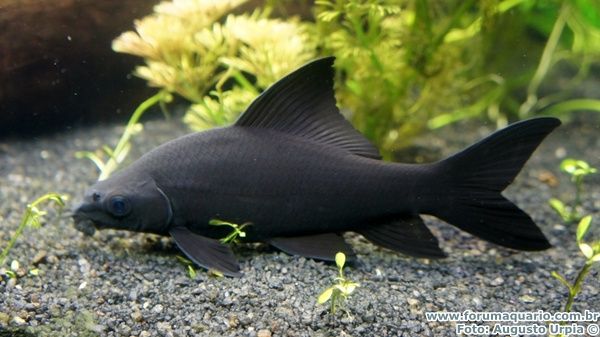
- Black Sharks are for those of you with a freshwater tropical aquarium of a very large size. These fish are usually sold at around 5cm – but end up an astonishing 60cm (that’s 2 foot!)
Common Name(s) : Black Shark
Family : Cyprinidae
Genus: Labeo
Species : Labeo chrysophekadion
Origin : Asia – Malaysia, Laos, Cambodia, Thailand, Sumatra and Borneo
PH : 6.0 – 7.5
Hardness : Slightly Hard to Moderately Hard
Temperature : 23 – 28°C / 73–82°F
Maximum Size : 60 cm / 24″
Lifespan : 5-15 years
Aggression Level : High – ok while young / Territorial when older (8/10)
Recommended Tank Size : 150 Litres +
Strata : Bottom Half
TANK SET UP
Will eagerly eat plants. Provide cover in the form of caves, driftwood, ornaments and rocks.
SUITABLE TANK MATES
- Possibly top dwelling large tropical specimens.
DIET
Omnivores, in the wild they eat very small invertebrates and plants. In the aquarium they will accept a wide range of foods including flake, small pellets, bloodworms and brine shrimp.
SEXING AND BREEDING
Sexing Black Sharks is very basic – males are skinnier while females are plumper. I know this is simple, there are no other distinguishable sexual differences. They are highly unlikely to breed in an aquarium.
OTHER USEFUL INFORMATION
Originating in Malaysia, Laos, Cambodia, Thailand, Sumatra and Borneo they are found in rivers, channels, streams and in floodplains. Due to their weight and size they are considered a good eating fish in these countries.
Black Sharks breed in the wet season in Asia, the onset of first monsoonal rains will see them migrate upstream to spawn.
In an aquarium, Black Sharks prefer a PH around neutral and a temperature between 22°C and 28°C. Keeping plants with this specimen is not a good idea as they will indulge leaf matter. As an omnivore their diet should be varied and they should be offered vegetable matter. We don’t have any problem with them taking flake and frozen food as they are not fussy eaters.
Black Sharks should be offered some hiding spaces for them to feel comfortable. They tend to live in the lower third of the aquarium and enjoy having a territory all to themselves. Larger specimens become aggressive and territorial.

Leave a Reply
You must be logged in to post a comment.